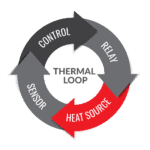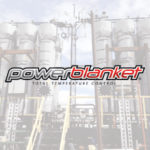Nearly 70% of process energy used in manufacturing comes from industrial heating operations. Almost everything we use requires heat to produce, including metal, plastic, rubber, concrete, composites, glass, and ceramics.
There is a wide range of process heating units and equipment, including hand-held heat guns, boilers, giant conveyor-type ovens, and blast furnaces. Producing heat energy requires one of four technologies: fuel, electricity, heat transfer media (steam, hot water, thermal fluids), and hybrids.
The following post provides an overview of process heating systems, fuel types, and components to assist you with selecting the right heating solution for your facility.
Elements Of A Process Heating System
A perfect heating system must be reliable, safe, cost-effective, user-friendly, efficient, and sustainable. An ideal heating system should also be able to stand up against unexpected weather conditions and emergencies without difficulties.
Almost every heating system has four primary components: a heat generator, a pump, heat recovery, and heat containers. Let’s break these down.
- Heat Generation Devices – These can be burners where natural gas or diesel fuel combusts or electric elements, as in ovens or kilns. Other process heat generators include lasers, electric arc furnaces, microwaves, induction heating, and electron beam (E-beam) irradiation.
- Heat Containers – Heat can go directly to the product, such as an induction smelter, or indirectly using heat-containing devices like ovens, boilers, furnaces, and kilns.
- Pumps or Fans for Circulation – In most processes, the heated air, water, steam, or another heat-transferring medium must circulate to distribute the heat.
- Heat Recovery – Efficient systems will use recovery devices to collect and use waste heat, usually heated air. Air-to-air heat exchangers use secondary heat to preheat air for other processes such as furnace makeup air or interior space heating.
It is a common goal for industries to seek a process heating system that protects the environment, provides maximum heat, and is cost-effective. Renewable energy and more efficient process heaters can reduce heat loss and gas emissions.
Most process heating equipment loses heat, so the Department of Energy offers a report, “Improving Process Heating System Performance,” to help operators reduce costs and increase efficiency. Proper insulation, design, and recovering waste heat to perform other processes are the best ways to maximize efficiency.
What are the 4 Types of Process Heating Systems?
Process heating systems, whether for general heating or a specific manufacturing operation, use one of these four technologies:
1. Fuel-Based Process Heating
Fuel-based systems burn solid, liquid, or gaseous fuels to generate heat. The hot combustion gas can transfer the heat directly via convection or indirectly using tubes or radiant burner panels that separate the gasses from the material. Examples of fuel-based process heating equipment are ovens, convection gas heaters, kilns, and smelters.
Furnaces utilizing this process can be batch or continuous types.
2. Electric-Based Process Heating
Electric-based process heating, called electro technologies, uses electric currents or electromagnetic waves to heat materials. Direct heating methods include passing an electrical current through the material, inducing an electrical (eddy) current into the material, or exciting the material’s atoms and molecules with electromagnetic fields using Radio frequency (RF) or Microwave (MW) energy.
For indirect heating, the energy flows only across the material’s surface or uses a susceptor material to transfer the heat to the product.
3. Heat Transfer Media or Steam-Based Process Heating
In this process, a boiler uses fuel to create steam. Steam holds a significant amount of latent heat energy, between 1,000 and 1,250 British Thermal Units per pound [BTU/lb.]. Steam delivers consistent power for process heating, pressure control, mechanical drives, separation of components, and hot water production for process reactions. Steam heating is more economical in lower-temperature industrial process heating (<400°F.) and is used in cogeneration, the simultaneous production of steam and electrical power.
Similar systems circulate a heat transfer media like water, oil, or another thermal fluid to distribute heat to the product.
4. Hybrid Systems
A hybrid system combines two process heating technologies using different heat sources. For example, a hybrid boiler can combine a fuel-based with an electric-based heat source. The electric boiler would kick in during off-peak times to lower the electricity cost.
Hybrid methods can use a heat recovery system drawing waste heat from another process to save energy.
Three Ways to Increase Industrial Process Heating Efficiency
Ideally, a heating system should work close to 100% energy efficiency, using all the heat it generates for one or more processes.
1. Process Heat Optimization
Understanding the current operations and energy needs and managing an industrial heat system is the first step toward optimizing the process. To achieve energy efficiency, you should consider the whole heat process system rather than the individual components. Optimization involves measuring and assessing the energy used in the entire system and each process stage.
Process heat optimization opportunities include:
- Controlling the air-fuel ratio and eliminating air leakages into direct-fire furnaces to improve combustion efficiency (burners) and other heat-generating equipment.
- Regularly maintaining furnaces and heating systems can increase the heat transfer from the heat source to the process load.
- Effective insulation of piping and related transfer equipment helps to trap and conserve heat, as well as systematic procedures for regular maintenance to reduce heat losses.
- Take advantage of automated measuring and controlling processes to avoid overheating and wasted heat.
- Avoid non-productive loads and idle periods to eliminate wasted heat.
2. Steam Systems Optimization
Steam is one of the most efficient and cost-effective heating sources. Its average usage throughout various industries is as much as 35-40% of overall onsite energy consumption.
Steam system optimization opportunities include:
- A steam flow meter provides valuable data for assessing boiler performance, efficiency and calculating the amount of steam required by a given system.
- Seal open vessels to prevent wastage of steam. Remove leaking and clogged steam traps to minimize lost steam.
- Minimizing the amount of gas used during boiler start-up and shut-down procedures.
- Using flash steam to recover heat during blowdown.
- Cogeneration and equipment drives on steam can dramatically improve system performance.
- Recover condensate and flash-steam.
- Using a feedwater economizer to improve boiler heat recovery.
- Insulate the distribution system.
In addition to installing steam recovery equipment such as water vapor economizers, which recover unused energy and recycle it back into the system, you can also save money by turning off equipment when it is not in use.
3. Waste Heat Recycling, Reduction, and Recovery
Most industrial systems generate waste heat. The most significant waste heat sources are exhaust or flue gasses, heated air from heating systems, heat from heat exchangers, cooling liquids, and gasses. Waste heat can also be in liquids or solids, such as cooling water, heated wash water, blowdown water, hot surfaces, and steam leaks. The waste streams vary in temperature, composition, and content.
Waste heat recycling or recovery uses waste heat from a process heating system for a secondary purpose. For example, using exhaust gas heat from a fuel-fired system to preheat the burner combustion air or makeup air for ovens or dryers. Preheating reduces the fuel required to establish and maintain the necessary process temperatures. One option is to use the flue gasses from process heaters to generate steam and electrical power or to heat feed water for other boilers.
Recycling waste heat can reduce energy usage by as much as 25%. Systems are relatively easy and inexpensive to implement. They work in 225°C or higher temperatures and recover between 30% to 90% of the waste heat.
Waste heat reduction or heat containment refers to reducing energy losses to the area surrounding process heating equipment.
The two primary heat loss areas are the walls and flue gasses of heating equipment. The hot surfaces of furnaces, boilers, dryers, and heat exchangers lose heat energy to the ambient spaces through radiation and convection. Sealing and insulating help increase efficiency and reduce heat loss.
Combining heat reduction with heat recycling will make any heating system as efficient as possible.
What is the Layout of a Complete Heating Solution?
At the beginning of most heating processes is fuel or an electrical source. For example, a storage tank may contain compressed LP gas. The gas must flow at a constant rate from the tank through piping and valves to the burners. The resulting heat would transfer to the product directly or indirectly inside a furnace, kiln, or steam boiler. Secondary heat recovery tubing can recover waste heat from the exhaust and use it to pre-heat air or water for other parts of the process.
Not all process heating requires high temperatures. Heat traces, drum heaters, and tank heaters work at a constant temperature of around 185°F (85 °C) or less.
A secondary heating solution may be necessary for tanks and piping exposed to freezing weather. A tank heater wraps around the tank, or an immersion heater inside the tank will maintain temperatures and prevent freezing. Additionally, a heat trace would follow the pipeline over any valves and instrumentation to ensure the correct temperature regardless of external conditions. Controllers monitor temperatures to prevent problems or alert personnel if one arises.
Powerblanket Custom Industrial Process Heating Systems
At Powerblanket, we develop custom process heating systems for industrial heating needs. Every manufacturer has unique requirements for heat depending on their space and the product.
We designed custom heating solutions for wind blade manufacturers, aerospace companies, and yacht builders. They all require direct heat to cure epoxy resins for their composite materials.
Heating is an issue for any industry that uses tanks to store compressed gas or liquids subject to cold winter temperatures. Solutions can include custom heated tank covers and immersion heaters to control viscosity and prevent valves from freezing. For heating in hazardous locations such as petrochemical facilities, Powerblanket offers solutions that are certified for C1D2 hazardous conditions.
Should you repair or replace it? Consider your options when your heating equipment is at the end of its lifespan. In most situations, investing in new custom heating solutions is better than spending more on the old ones.
Frequently Asked Questions
What are the main parts of the heating system?
A central heating system typically includes a heat generator like a boiler, pipework for circulation, radiators for heat distribution, and a pump to move heated water through the system.
What does a heating system include?
A heating system includes components such as a heat generator, heat containers, pumps or fans for circulation, and heat recovery systems to efficiently distribute and utilize thermal energy.
What are the main components of an HVAC system?
The main components of an HVAC system include a heat generator (like a furnace or boiler), a thermostat for temperature control, an air handler, ductwork for air distribution, and a heat exchanger for transferring heat.
What are the main components of a car heating system?
A car heating system consists of a heater core, blower motor, heater hoses, heater control valve, and an HVAC control panel to manage the temperature inside the vehicle.
When you need a custom temperature control solution, Powerblanket is the company to call. With decades of experience, we can solve any heating dilemma you have.





